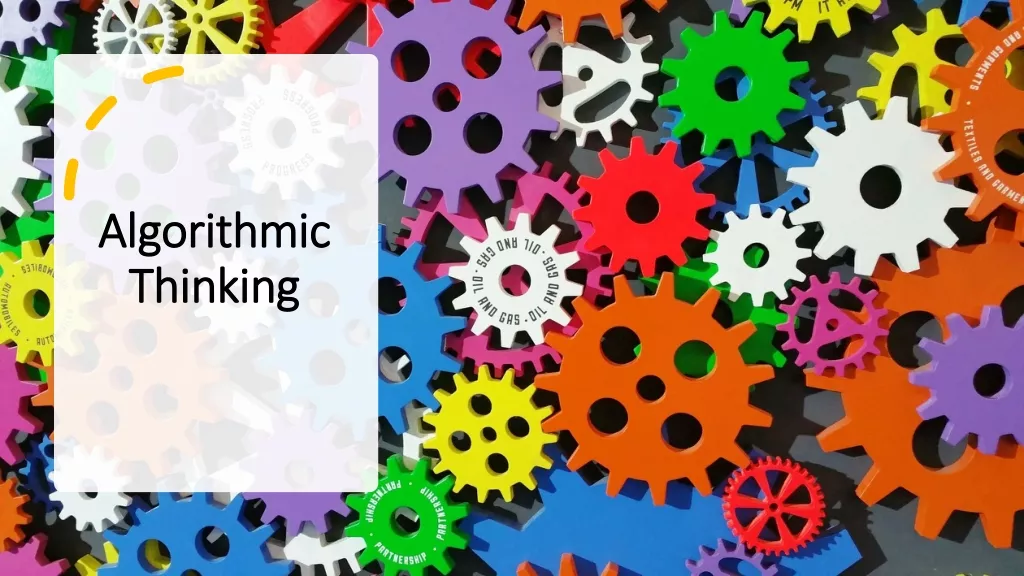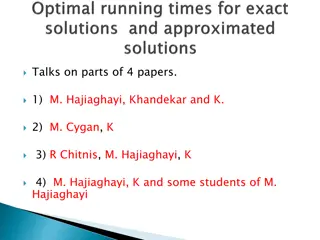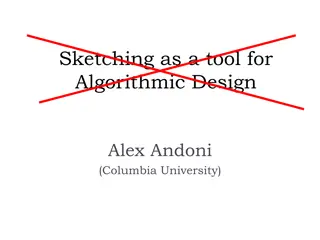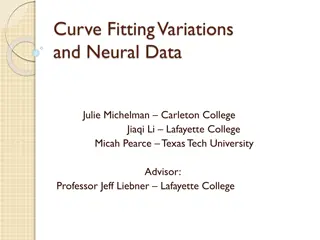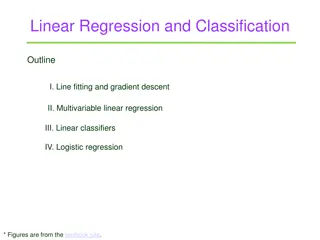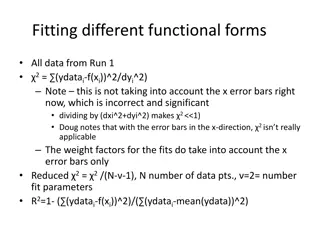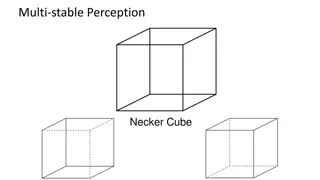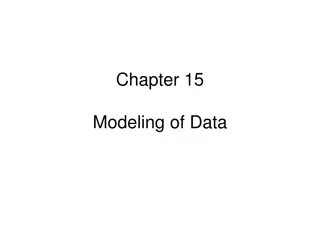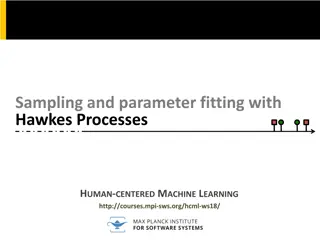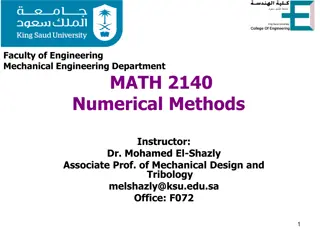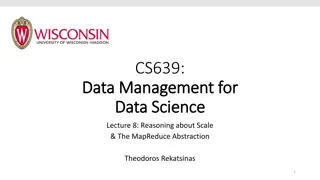Algorithmic Issues in Tracking: A Deep Dive into Mean Shift, EM, and Line Fitting
Delve into algorithmic challenges in tracking tasks, exploring techniques like mean shift, Expectation-Maximization (EM), and line fitting. Understand the complexities of differentiating outliers and inliers, with a focus on segregating points into best-fit line segments.
Download Presentation

Please find below an Image/Link to download the presentation.
The content on the website is provided AS IS for your information and personal use only. It may not be sold, licensed, or shared on other websites without obtaining consent from the author.If you encounter any issues during the download, it is possible that the publisher has removed the file from their server.
You are allowed to download the files provided on this website for personal or commercial use, subject to the condition that they are used lawfully. All files are the property of their respective owners.
The content on the website is provided AS IS for your information and personal use only. It may not be sold, licensed, or shared on other websites without obtaining consent from the author.
E N D
Presentation Transcript
CS5112: Algorithms and Data Structures for Applications Lecture 21: Algorithmic issues in tracking Ramin Zabih Some content from: Wikipedia/Google image search
Lecture Outline Applying mean shift to tracking Expectation maximization RANSAC M-estimation Least squares fitting
Tracking overview Suppose we want to figure out how fast and what direction (L- R) a robot is moving We can just run segmentation on consecutive frames Not too much changes in 1/30 of a second Usually you can carry over some information from previous frame
The ideal robot 12 12 10 10 8 8 Mileage Mileage 6 6 4 4 2 2 0 0 0 0 1 1 2 2 3 3 4 4 5 5 6 6 Time Time
The real (lying) robot 12 10 8 Mileage 6 4 2 0 0 1 2 3 4 5 6 Time
Real problem is much worse Some of the time we will track a different object This gives us outliers (from other object) Versus inliers (from the object we want to track)
Simplified tracking problem Line fitting Goal: To group a bunch of points into two best-fit line segments 9
Chicken-egg problem If we knew which line each point belonged to, we could compute the best-fit lines. 10
Chicken-egg problem If we knew what the two best-fit lines were, we could find out which line each point belonged to. 11
Expectation-Maximization (EM) Initialize: Make random guess for lines Repeat: Find the line closest to each point and group into two sets. (Expectation Step) Find the best-fit lines to the two sets (Maximization Step) Iterate until convergence The algorithm is guaranteed to converge to some local optima 12
Example: 13
Example: 14
Example: 15
Example: 16
Example: Converged! 17
Expectation maximization Standard use case is to separate two gaussians (MOG) If we knew which data is water and which is beer, we could compute the mean and variance separately If we know the mean and variance were for beer and water, we could figure out which data is water and which is beer But we don t know anything! So, just like in k-means, we guess and iterate
ANEMIA PATIENTS AND CONTROLS 4.4 4.3 Red Blood Cell Hemoglobin Concentration 4.2 4.1 4 3.9 3.8 From P. Smyth ICML 2001 3.7 3.3 3.4 3.5 3.6 3.7 3.8 3.9 4 Red Blood Cell Volume
EM ITERATION 1 4.4 Red Blood Cell Hemoglobin Concentration 4.3 4.2 4.1 4 3.9 3.8 From P. Smyth ICML 2001 3.7 3.3 3.4 3.5 3.6 3.7 3.8 3.9 4 Red Blood Cell Volume
EM ITERATION 3 4.4 Red Blood Cell Hemoglobin Concentration 4.3 4.2 4.1 4 3.9 3.8 From P. Smyth ICML 2001 3.7 3.3 3.4 3.5 3.6 3.7 3.8 3.9 4 Red Blood Cell Volume
EM ITERATION 5 4.4 Red Blood Cell Hemoglobin Concentration 4.3 4.2 4.1 4 3.9 3.8 From P. Smyth ICML 2001 3.7 3.3 3.4 3.5 3.6 3.7 3.8 3.9 4 Red Blood Cell Volume
EM ITERATION 10 4.4 Red Blood Cell Hemoglobin Concentration 4.3 4.2 4.1 4 3.9 3.8 From P. Smyth ICML 2001 3.7 3.3 3.4 3.5 3.6 3.7 3.8 3.9 4 Red Blood Cell Volume
EM ITERATION 15 4.4 Red Blood Cell Hemoglobin Concentration 4.3 4.2 4.1 4 3.9 3.8 From P. Smyth ICML 2001 3.7 3.3 3.4 3.5 3.6 3.7 3.8 3.9 4 Red Blood Cell Volume
EM ITERATION 25 4.4 Red Blood Cell Hemoglobin Concentration 4.3 4.2 4.1 4 3.9 3.8 From P. Smyth ICML 2001 3.7 3.3 3.4 3.5 3.6 3.7 3.8 3.9 4 Red Blood Cell Volume
RANSAC algorithm How many times? Run k times: (1) draw n samples randomly (2) fit parameters with these n samples (3) for each of other N-n points, calculate its distance to the fitted model, count the number of inlier points, c Output with the largest c How big? Smaller is better How to define? Depends on the problem.
Count inliers c=3
Another trial c=3
The best model c=15
RANSAC failure mode Not every all-inlier sample gives a model consistent with all inliers
General model fitting problem We have some data points (??,??) and some possible models, each of which has some parameters ? Example: line fitting, ? = ?? + ? A model predicts ?(?;?) What set of parameters gives the best fit to the data? For a particular , the residuals are 35
Least squares fit The least squares fit says that the best fit minimizes ???2 Sum of the squared residuals At the correct selection of points, what are the residuals? They are generally small and gaussian 36
1 bad point can ruin your whole line Example c/o Kim Boyer, OSU
Problem is subtle You can t simply do an LS fit and then declare the worst-fitting point to be bad There are examples where the bad data is fit better than the good data Robust statistics addresses this problem A robust fitting method tolerates outliers Obviously, LS is not robust Note that in vision, the term robust sometimes simply means good 38
Robust model fitting There are two problems with the LS fit We square the residuals We sum up these squares The main approaches in robust statistics address each of these problems The problem with squaring the residuals is that the squared values get too large 39
M-estimation Suppose that our measure of goodness of fit is ??(??), where Here, ? is a scale parameter All residuals worse than s count like s The scale parameter essentially controls the boundary between inliers and outliers We expect outliers to have residuals larger than s, but not inliers How do we pick s? 40
Computing a robust fit It s possible to perform M-estimation fairly efficiently using a variant of least squares Think of ??, where ? is a matrix and ? is a vector, as a linear combination of the columns of ?, weighted by elements of ? Example for the model ? = ?? + ? and data (??,??) ? has (?? 1) rows, one per data point ? = ? ?? ?? = ?1, ,?? ?= ? 41
Computing a LS fit If we consider all possible choices of ? we span a subspace. The solution to ?? = ?is the coordinates of ? in terms of the columns of ? What if ?isn t in the subspace? We can ask for the point in the subspace that is as close as possible to ? (the least squares fit) 42
Solving least squares The least squares solution to ?? = ? is argmin | ? ?? | ? An elegant result, due to Gauss, is that the solution to this is the pseudoinverse ??? 1??? Easy to re-derive: ??? is square! If we weight each residual by ?? we get argmin ? Here, ? is a diagonal matrix of ?? = ???2? 1???? ? ? ?? 43
Iterative reweighted least squares IRLS algorithm Start with all weights being 1 Compute least squares fit and residuals Adjust ? to reduce the weighting of the large residuals Re-fit and repeat 44


